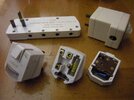Hello,
I need to wire up four different LED strips at points along a 15m wall. The power socket is about 5m away from the nearest set.
Ideally I wouldn't have four individual extension cables. Is it possible to wire 4 x trailing single sockets along one cable, as per the attached sketch? Or would this risk overloading?

I need to wire up four different LED strips at points along a 15m wall. The power socket is about 5m away from the nearest set.
Ideally I wouldn't have four individual extension cables. Is it possible to wire 4 x trailing single sockets along one cable, as per the attached sketch? Or would this risk overloading?



